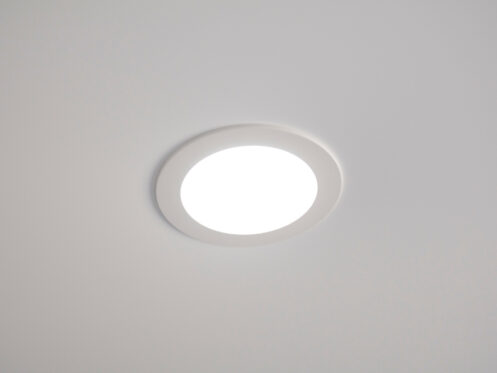Lighting plays a key role in both residential and commercial settings, and safety is a primary concern when installing recessed lighting fixtures. One of the most important factors to consider is the IC rating. Understanding IC ratings is important for safety, energy efficiency, and compliance with electrical codes.
Learn what IC-rated means for lighting and how the electricians at High 5 can help with electrical services in your Denver area home.
Role of IC Rating in Lighting
When shopping for new or replacement light fixtures, you may have seen the letters IC next to the bulbs and wondered, “What does IC-rated mean?” The IC rating, or Insulation Contact rating, determines whether a lighting fixture can safely come into direct contact with the insulation materials in ceilings and walls. When a light fixture generates heat, it can pose a fire risk if installed near insulation without proper protection.
What is IC-rated recessed lighting? These fixtures are designed to minimize heat buildup and prevent potential fire risks by maintaining a low surface temperature. They allow for safe installation in insulated ceilings, providing homeowners and businesses with peace of mind.
Benefits of IC-Rated Lighting Fixtures
Using IC-rated lighting fixtures comes with several benefits, including:
- Fire safety: IC-rated fixtures reduce the risk of overheating and fire hazards by preventing insulation materials from catching fire.
- Energy efficiency: These fixtures are designed to minimize heat loss, making them more energy-efficient and reducing overall heating and cooling costs.
- Durability: IC-rated fixtures are built to withstand prolonged use without damage from excessive heat.
- Compliance with building codes: Many building regulations require IC-rated fixtures in insulated spaces to ensure safety.
- Versatility: IC-rated fixtures are suitable for various applications, including residential, commercial, and industrial settings.
IC Rating Criteria
For a lighting fixture to receive an IC rating, it must meet these specific safety and performance criteria:
- The fixture must be capable of operating safely when in direct contact with insulation.
- The housing and components must be made of materials that resist overheating.
- The fixture should maintain a surface temperature of 194°F or lower when fully enclosed.
- The design should allow for efficient heat dissipation, reducing the risk of damage to surrounding materials.
- It should comply with industry safety standards, such as those set by the U.S. Department of Energy.
Types of IC Ratings
There are different types of IC ratings based on a fixture’s design and insulation compatibility. The three main types are IC-AT (Insulation Contact Airtight), IC-rated fixtures, and non-IC-rated fixtures. IC-AT fixtures are designed to be installed in direct contact with insulation and are also airtight, enhancing energy efficiency.
IC rating vs. non-IC rating
IC-rated fixtures are specifically designed to be in direct contact with insulation. These fixtures use thermal protection mechanisms to regulate heat and prevent fire hazards. They’re commonly used in residential and commercial settings with insulation in the ceiling.
Non-IC-rated fixtures can’t safely contact insulation. They generate more heat and require at least three inches of space between the fixture and any insulation material. If improperly installed, non-IC-rated fixtures can pose a significant fire risk.
IC Rating Compliance
IC-rated lighting fixtures must comply with national and local building codes. In the United States, the National Electrical Code (NEC) and other regional regulations provide guidelines for IC-rated fixtures. Compliance ensures that lighting installations are safe and do not pose risks to occupants.
Building inspectors and electricians assess lighting installations to verify adherence to these codes. Failure to install IC-rated fixtures where required can lead to safety hazards, code violations, and potential fines.
Installation of IC-Rated Fixtures
Proper installation of IC-rated fixtures is important for performance and safety. Installation steps include:
- Step one: Switch off the electricity before installing or replacing a fixture to prevent electrical shock.
- Step two: Choose the correct fixture. If being installed in an insulated ceiling, make sure the fixture is IC-rated.
- Step three: Check for adequate clearance — IC-rated fixtures require proper spacing from structural elements to allow for sufficient ventilation.
- Step four: Secure the fixture in place using the appropriate mounting brackets and fasteners.
- Step five: Connect wiring by following manufacturer instructions and adhering to electrical codes.
- Step six: Turn on the power and test the fixture to ensure it functions correctly.
Hiring a professional electrician helps ensure proper installation and compliance with safety regulations.
Maintenance and Care for IC-Rated Fixtures
Regular maintenance and care help keep IC-rated fixtures functioning optimally. Some maintenance tips include:
- Clean regularly: Dust and debris accumulate on light fixtures, affecting performance. Wipe them down periodically to maintain brightness.
- Check for overheating: IC-rated fixtures are designed for insulation contact, but prolonged overheating may indicate an issue with insulation coverage or ventilation.
- Inspect wiring: Loose or damaged wiring can pose a safety hazard. Conduct periodic inspections or have an electrician assess the fixture.
- Replace bulbs with compatible options: Use bulbs that meet the fixture’s recommended wattage to prevent excessive heat.
Considering Installing IC-Rated Light Fixtures? Contact the Team of Electricians at High 5
If you’re planning to install IC-rated lighting fixtures in your home or business, it’s important to work with qualified professionals. High 5’s team of experienced electricians can help you select, install, and maintain IC-rated fixtures safely. Our experts determine compliance with all safety standards and building codes while delivering high-quality lighting solutions.
For the best electrician services in the Denver region, contact our team without delay. We know how important it is to have power throughout your home and that just one malfunctioning light or socket can be a major inconvenience. We can help guide you to the right solution.

